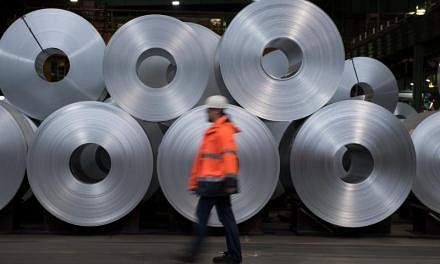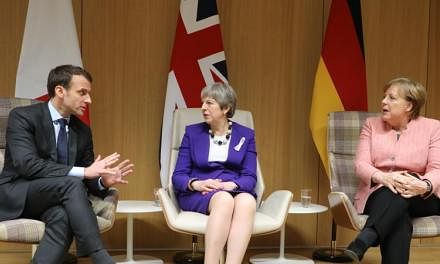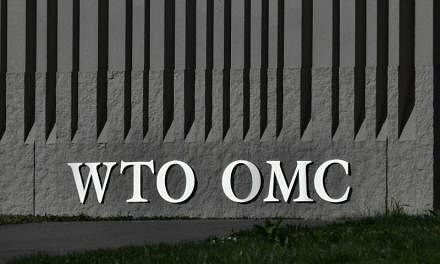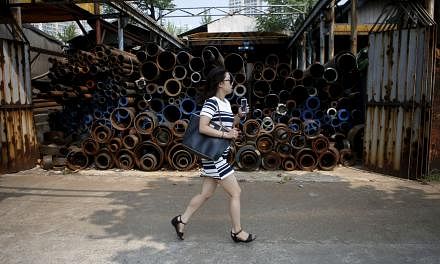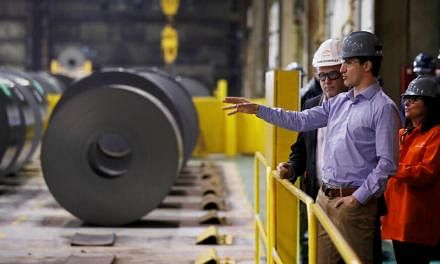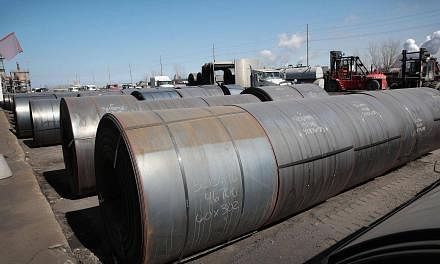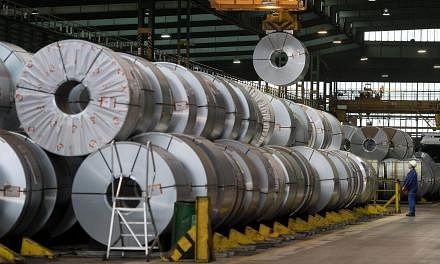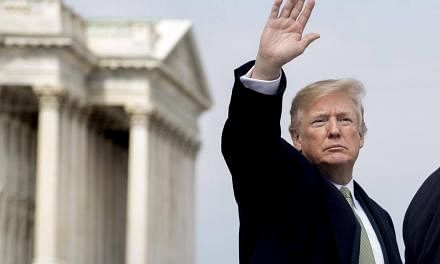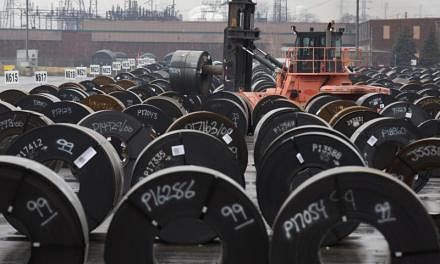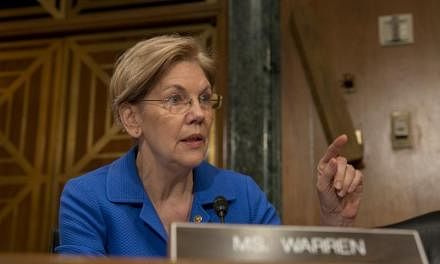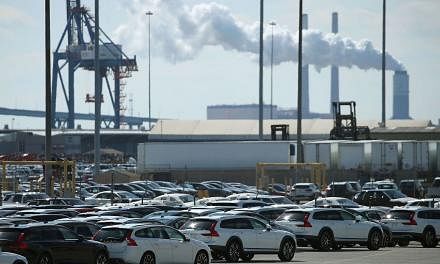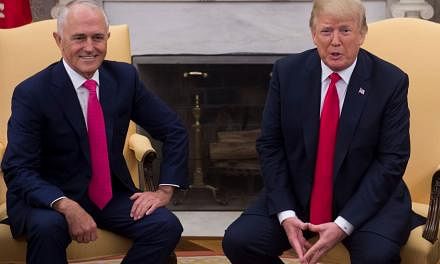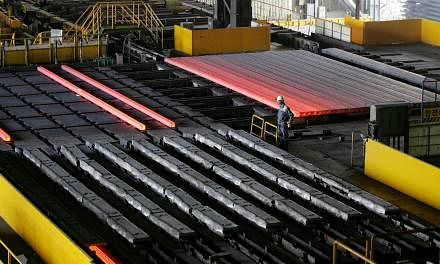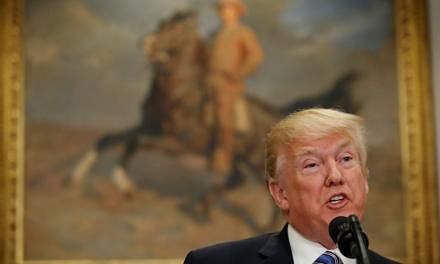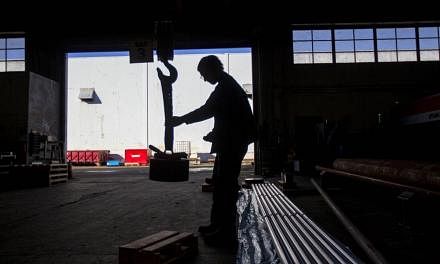NEW YORK (NYTIMES) - US President Donald Trump announced on Thursday (March 1) that his administration would impose a 25 per cent tariff on imported steel and a 10 per cent tariff on imported aluminium, on the grounds that other countries' trade practices involving the metals endanger US national security by undermining domestic production.
The tariffs are expected to apply to all countries, according to an industry executive briefed on the president's plans.
Trump reportedly told a group of executives that he did not want any nation to be exempted from the order, arguing that if one country was exempt, all other countries would be in line to ask for similar treatment.
Here's what you need to know.
WHAT IS A TARIFF?
It is simply a tax placed on some particular class of imported goods.
If the Trump administration follows through on the president's comments on Thursday, a company bringing US$100,000 (S$132,400) of steel made in Canada into the United States would have to pay US$25,000 to the government, effectively increasing its price.
Tariffs are typically a tool governments use to protect domestic industries and raise revenue.
WAIT, WHY DID YOU SAY 'IF' THE ADMINISTRATION FOLLOWS THROUGH?
The president made the announcement at an event that was pulled together hastily, and while his preferences were broadly known, congressional Republicans and business lobbyists were still taken by surprise.
By Thursday afternoon, allies of the president were imploring him to change his mind. The new tariffs are set to go into effect next week.
Although Trump's complaints about unfair trading practices by China and other countries have been a hallmark of his years in public life, it appears the details of this policy have not been fully worked through.
The White House offered no real implementation details.
WHAT IS THE RATIONALE?
US steel and aluminium companies have long complained of unfair practices by overseas competitors, especially Chinese state subsidies that encourage production.
This can flood the global marketplace with metals, depress prices and make US production less economical than it otherwise would be.
This is a long-standing complaint that US trade officials have sought to redress in various ways, including a decision by the George W. Bush administration in 2002 to impose steel tariffs of up to 30 per cent.
But that was a more narrowly targeted law aimed at safeguarding domestic industries harmed by imports. The Trump administration has used that provision to impose tariffs on imported solar panels and washing machines.
The Trump administration is on more uncharted ground by basing the tariffs on national security concerns - Section 232 of a law enacted in the Cold War.
The argument is that by undermining domestic metals production, the United States is left vulnerable in the event of conflict that disrupts trade flows.
Expect furious lobbying in the days ahead to try to persuade the president to exclude military allies' metals from the tariffs.
Defence Secretary James Mattis has warned that tariffs should be targeted so as not to damage relationships with allies, but it appears the president did not heed that advice.
WHO WINS AND WHO LOSES?
The big winners are the US steel and aluminium industries. For years, those industries have lobbied for more aggressive government action against what they view as unfair practices by global competitors, and they're now getting their way.
The most immediate losers are the industries that rely on steel and aluminium as an input and will face higher prices.
That includes some of the nation's biggest industries: the automobile sector, aerospace, heavy equipment and construction.
In short, the chassis of a Ford, the body of a Caterpillar bulldozer, the wings of a Boeing aircraft, and the steel girders inside a New York skyscraper are all about to get more expensive.
After the president's announcement, Wall Street quickly reflected this divide: Shares of US Steel and Century Aluminum were each up about 7 per cent shortly afterward, while shares of Ford, Caterpillar and Boeing were each down about 3 per cent.
The industries that use steel and aluminium are considerably larger as a share of the US economy than are steel and aluminium producers.
By one estimate, from Lydia Cox of Harvard and Kadee Russ of the University of California-Davis, steel-using industries employ 80 times as many people as steel-producing industries.
But history shows that imposing tariffs to protect one industry often results in pain for another. According to industry groups, some 6.5 million people are employed in the US in businesses that use steel and aluminium, Financial Times reported.
Global Automakers said that President George W. Bush's 2002 steel tariffs cost the economy 200,000 jobs, including 30,000 in Michigan, Ohio and Pennsylvania.
BUT WHAT DOES THIS MEAN FOR CONSUMERS?
The simple answer is that goods containing metals will become more expensive. But there's not much reason to expect enormous price increases for most goods.
First, the United States imports only about one-third of its steel, and the tariff would not apply to domestic production.
Aluminium is more heavily dependent on imports, with only 10 percent made domestically.
So prices will go up by only a fraction of the tariff amount. But consumers don't generally buy raw steel and aluminium.
People buy consumer goods in which those raw materials are but one input. A car includes not just steel and aluminum but also plastics and textiles and glass, not to mention the computer circuitry that controls it all, the design know-how and assemblage work, along with a profit margin for both the automaker and the dealer.
For any given product, it is hard to predict whether producers will eat the cost of more expensive metals, pass the cost on in the form of higher prices, or both.
Put differently: If your favourite beer producers are looking at paying an extra fraction of a cent for each aluminium can, they might just eat the cost, they might raise prices, or they might split the difference. It is hard to know in advance how much of each will take place.
SO DOES THIS MATTER FOR THE ECONOMY?
The American economy is relatively strong at the moment, and has been historically resilient to most disruptions. And companies are good at restructuring their supply chains to minimise disruption because of tariffs like these.
In most retrospective analyses, the 2002 Bush administration steel tariffs have been judged to be costly relative to the jobs that were saved, but they were hardly the cause of some economic disaster.
The action may create some jobs in metals-producing industries, cost some jobs in fields where steel and aluminium are inputs, and push consumer prices a bit higher. The large and dynamic US economy can handle it.
The risk comes from the potential ripple effects.
Affected countries may well retaliate by ordering tariffs on American goods, and they could carefully target goods to cause economic or political pain.
US exporters - whether they sell passenger airplanes or soybeans - should be nervous about the next shoe to fall. There are few winners in an all-out trade war like one that enveloped the world economy in the 1930s.
In particular, the Trump administration's invocation of national security concerns could set a precedent in which China and other nations are willing to use national security as grounds for tariffs, hurting the ability of the World Trade Organisation to arbitrate disputes.
The real risk isn't that steel and aluminium are a bit more expensive, though that is likely to be the case. It is that an entire system of global trade the United States built might be undermined.

